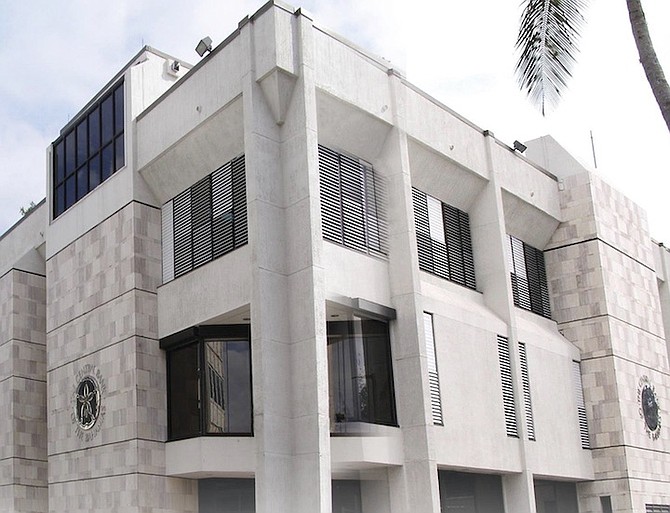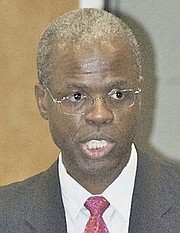• Governor: GDP must expand to absorb new workers
• But reaffirms 8% growth forecast remains for 2022
• Warns Federal Reserve ‘tightening’ could impact
By NEIL HARTNELL
Tribune Business Editor
nhartnell@tribunemedia.net
The Central Bank’s governor yesterday warned that returning to pre-COVID economic output “is not enough” as he reaffirmed forecasts that GDP will expand by 8 percent in 2022.
John Rolle, addressing the Bahamas Business Outlook conference, said the continued expansion of the workforce - with several thousand school leavers having swelled its ranks further in the two years since the pandemic began - made it imperative that this nation not merely settle for returning to 2019 gross domestic product (GDP) levels.
Predicting that The Bahamas will catch up to pre-COVID output in 2023, he warned that the economy still faces potential headwinds that could throw it off this year’s growth estimates. Besides the case surge sparked by the Omicron variant, the governor said policy tightening by the Federal Reserve and other foreign central banks to combat inflation could impact tourism demand.
But, while the Federal Reserve has indicated it could raise US interest rates three times in 2022, starting as early as March, Mr Rolle suggested “pent-up demand” among American travellers was strong enough in the short-term to offset any negative Bahamian tourism industry impact from a rise in borrowing and debt servicing costs in its major visitor source market.
Conceding that the need for “healthier economic growth” was among the key lessons for The Bahamas from the pandemic, he said: “If we look at 2022, that’s the period we’ve just begun, our economy is going to be very much in recovery mode.”
With the economy having started to “recoup growth” lost to COVID-19 in 2021, following a 2020 in which GDP was considered to have shrunk by up to $2bn, Mr Rolle added: “We expect in 2022 that The Bahamas will grow in the region of 8 percent or just above that.
“That still reflects that we’re trying to get back to where we were in 2019, and expect to conclude this recovery to 2019 in 2023.” The 8 percent GDP expansion forecast would be among the highest annual growth rates ever achieved by The Bahamas if attained. However, it merely represents ground being recovered that was lost to COVID-19 in 2020 and is not forecast to be sustained.
And while The Bahamas was likely to “get back to full capacity” before the 2024 timeline forecast for other Caribbean and tourism-dependent economies, Mr Rolle said this nation must strive for further - and higher - annual GDP growth and not rest on its laurels.
“Getting back to 2019 is not enough,” he warned Business Outlook attendees. “We are making whole people who participated in the economy in 2019, but people have continued to join the labour force and some of what is ahead of us is ensuring the economy grows to absorb new entrants into the workforce.
“What the pandemic has taught us is we want healthier economic growth. Part of the reset is making changes and reforms that make the economy more agile, and position the economy to grow faster in the future. Not all of that is an overnight change.”
The Bahamian economy was failing to achieve sufficiently high growth rates to fully absorb all annual school leavers into the workforce even prior to Hurricane Dorian and COVID-19, meaning that these two events will only have worsened this problem.
Besides the need to “take control as much as possible of factors in our direct reach” when it came to managing the COVID-19 pandemic, Mr Rolle warned that inflation - representing a sustained increase in the cost of goods and services - will be “an issue for us” in 2022 both domestically and internationally.
“We have to be mindful of how the Federal Reserve and central banks respond to fighting inflation in those countries,” he added. “While we see tourism as still having a lot of pent-up room for expansion, we have to be mindful of the Federal Reserve increasing interest rates to combat inflation.
“That will impact growth and filter through to the demand for tourism. But, in the short term, there is a lot of pent-up demand for tourism that will not be impacted by the tightening of policy in the US.”
Any increase in US interest rates would raise borrowing and debt servicing costs, leaving Americans with less disposable income and spending power, and causing them to feel less well-off. The US inflation rate in December stood at 7 percent year-over-year, while also increasing month-on-month by 0.5 percent.
That represented the seventh consecutive month in which US inflation has exceeded 5 percent, reducing the hope that the price/cost increases were a temporary phenomenon caused by COVID and the supply chain crisis. Bahamian domestic consumers, too, will not be immune from inflation’s impact here in 2022.
“We expect Bahamians will see more of the inflation that is happening outside The Bahamas. We will see it in the goods and services we import,” Mr Rolle said. “We shouldn’t expect a one:one relationship between our inflation and US inflation. Inflation is a reflection of the goods and services we consume and, in the case of The Bahamas, our consumption basket is different from the US.”
The Central Bank governor argued that hours worked in the hotel and tourism industry are a better indicator of employment than actual job numbers, suggesting that underemployment was a better benchmark through which to determine the workforce’s post-COVID rebound.
Focusing solely on employment numbers “might mislead,” Mr Rolle said, adding that hours worked in the sector would likely continue to increase throughout 2022 as tourism rebounds. The industry’s workers had also experienced the “greatest setbacks” to their personal finances as a result of the pandemic, but would start to catch up on their debts and bills this year.
The Central Bank governor also disclosed that The Bahamas’ foreign currency reserves, which underpin the one:one fixed currency peg with the US dollar, had finished 2021 at $2.4bn, which he described as “the highest level at which we’ve closed a calendar year”.
While the Government’s foreign currency borrowing during the pandemic drove much of the external reserves growth, Mr Rolle said the regulator expected that increased economic activity would drive a drawdown on that stockpile in 2022. “That translates into the Central Bank’s comfort that it’s able to absorb increased spending from the population,” he added of the reserves.
Mr Rolle said “one area of the economy that will not see much traction” in 2022 is greater commercial bank lending, adding that the sector faced a “more drawn out path” to recovery that will depend on how rapidly its existing borrowers rebound.
The credit bureau’s initiation of the first-ever credit scores and reports will also “have some impact”, but Mr Rolle said its start will bring longer-term benefits to the provision of credit in The Bahamas.






Comments
tribanon 2 years, 6 months ago
Rising oil/fuel prices, rapidly escalating inflation impacting everything else imported into our country, plus interest rates about to rise on the now very significant portion of our nation's foreign currency denominated debt, all point to great pressure being put on the already insufficient level of our foreign currency reserves.
Sign in to comment
OpenID